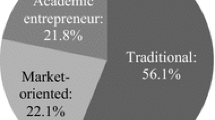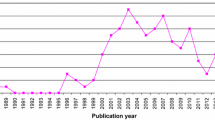Abstract
This study investigates the factors that shape the attitudes of scientists toward starting their own business or working in a private sector firm. The analysis is based on data collected from scientists working in the German Max Planck Society, a research institution devoted to basic science. We find that the scientists’ attractiveness of working in a private sector firm or of starting their own business differ considerably according to their academic discipline and the self-reported commercial potential of their research. The ability to take risks, prior work experience in private firms, and personal experience in cooperating with industry lead to a positive attitude towards switching to private sector employment or entrepreneurship. Strong willingness to freely distribute research findings is related to a low appeal of private sector work.


Similar content being viewed by others
Notes
A. Einstein, ‘Autobiographical notes’, in: A. Einstein: Philosopher-Scientist. 1949. Everton (Ill.), ed. P. A. Shilpp.
This supports the supposition that attractiveness does not necessarily coincide with intention (see e.g. Ajzen 1991).
According to Stuart and Ding (2006), scientists are more likely to become entrepreneurs if peers at their institute are involved in commercial science. Bercovitz and Feldman (2008) show that organizational influence stimulates the entrepreneurial activity of scientists as scientists tend to learn to adopt the behavior of peers.
Note that among doctoral students in the humanities, no nascent entrepreneur is found, so that we disregard this variable in the analysis.
Statistics are available upon request.
We are not aware of any comparable study that could serve as a reference to the shares detected by us.
However, the study by Ponomariov and Boardman relates to informal interaction of academic scientists with private firms rather than job movements between sectors.
Our measures of peer influence relate to the mean entrepreneurial attractiveness and the share of nascent entrepreneurs—regardless of scientists’ own observation. Bercovitz and Feldman (2008) observe peer effects by regarding cases when scientists switch from one institution to another while Stuart and Ding (2006) regard the entrepreneurial activity of past co-workers. Therefore, the three measures can hardly be compared.
References
Agrawal, A. (2006). Engaging the inventor: Exploring licensing strategies for university inventions and the role of latent knowledge. Strategic Management Journal, 27(1), 63–79.
Agarwal, R., Echambadi, R., Franco, A. M., & Sarkar, M. B. (2004). Knowledge transfer through inheritance: Spin-out generation, development and survival. Academy of Management Journal, 47(4), 501–522.
Agrawal, A., & Henderson, R. (2002). Putting patents in context: Exploring knowledge transfer from MIT. Management Science, 48(1), 44–60.
Ajzen, I. (1991). The theory of planned behavior. Organizational Behavior and Human Decision Processes, 50(2), 179–211.
Azoulay, P., Ding, W. W., & Stuart, T. (2006). The impact of academic patenting on (public) research output. NBER Working Paper #11917.
Bercovitz, J., & Feldman, M. (2008). Academic entrepreneurs: Organizational change at the individual level. Organization Science, 19(1), 69–89.
Buenstorf, G. (2009). Is commercialization good or bad for science? Individual-level evidence from the Max Planck Society. Research Policy, 38(2), 281–292.
Charles, D., & Conway, C. (2001). Higher education–business interaction survey: A report to the UK HE funding bodies and the Office of Science and Technology. Newcastle: University of Newcastle upon Tyne.
Cohen, W. M., Florida, R., Randazzese, L., & Walsh, J. (1998). Industry and the academy: Uneasy partners in the cause of technological advance. In R. Noll (Ed.), Challenges to the research university (pp. 171–198). Washington, DC: Brookings Institution.
Cohen, W. M., Nelson, R. R., & Walsh, J. (2002). Links and impacts: The influence of public research on industrial R&D. Management Science, 48(1), 1–23.
Colombo, M. G., & Grilli, L. (2005). Founders’ human capital and the growth of new technology–based firms: A competence–based view. Research Policy, 34(6), 795–816.
Dietz, J. S., & Bozeman, B. (2005). Academic careers, patents, and productivity: industry experience as scientific and technical human capital. Research Policy, 34(3), 349–367.
Dohmen, T., Falk, A., Huffman, D., Sunde, U., Schrupp, J., & Wagner, G.G. (2005). Individual risk attitudes: New evidence from a large, representative, experimentally-validated survey. DIW Discussion Paper 511, available at http://193.174.141.131/documents/publikationen/73/43553/dp511.pdf. Accessed October, 15th, 2009.
Etzkowitz, H. (1998). The norms of entrepreneurial science: cognitive effects of the new university-industry linkages. Research Policy, 27(8), 823–833.
Fishbein, M., & Ajzen, I. (1975). Belief, attitude, intention, and behavior: An introduction to theory and research. Reading, MA: Addison-Wesley.
Gittelman, M. (1999). Knowledge as property: Innovation in biotechnology in the United States and in France. In: Academy of Management Proceedings, IM: L1–L6.
Herrera, L., Muñoz-Doyague, M. F., & Nieto, M. (2010). Mobility of public researchers, scientific knowledge transfer, and the firm’s innovation process. Journal of Business Research, 63(5), 510–518.
Krabel, S., & Mueller, P. (2009). What drives scientists to start their own company?: An empirical investigation of Max Planck Society scientists. Research Policy, 38(6), 947–956.
Libaers, D. (2009). Industry relationships of DoD-funded academics and institutional changes in the US University system. Journal of Technology Transfer, 34(5), 474–489.
Lin, M.-W., & Bozeman, B. (2006). Researchers’ industry experience and productivity in university-industry research centers: A ‘scientific and technical human capital’ explanation. Journal of Technology Transfer, 31(2), 269–290.
Link, A. N., & Ruhm, C. J. (2010). Public knowledge, private knowledge: The intellectual capital of entrepreneurs. Small Business Economics, (forthcoming).
Link, A. N., & Siegel, D. S. (2007). Innovation, entrepreneurship and technological change. Oxford: Oxford University Press.
Lowe, R. A., & Gonzalez-Brambila, C. (2007). Faculty entrepreneurs and research productivity. Journal of Technology Transfer, 32(3), 173–194.
Mangematin, V. (2000). PhD job market: Professional trajectories and incentives during the PhD. Research Policy, 29(6), 741–756.
Mansfield, E. (1995). Academic research underlying industrial innovation. Review of Economics and Statistics, 77(1), 55–65.
Martinelli, D. (2001). Labour market entry and mobility of young French PhDs. In: Innovative people—Mobility of skilled personnel in national innovation systems. OECD Proceedings, 2001, 159–173.
Max Planck Society (2009). Max Plank Society: Annual Report 2008, available at http://www.mpg.de/pdf/jahresbericht2008/jahresbericht2008.pdf, Accessed February, 9th, 2009.
Noll, R. (1998). Challenges to research universities. Washington, DC: Brookings Institution.
OECD (2002). International mobility of the highly skilled. OECD Report, Paris, available at: http://pesona.mmu.edu.my/~chtan/Seminar/9202011E.pdf?bcsi_scan_2A2102422E3B7B6B=0&bcsi_scan_filename=9202011E.pdf, Accessed August, 15th, 2009.
Pavitt, K. (1998). The social shaping of the national science base. Research Policy, 27(8), 793–805.
Perkmann, M., & Walsh, K. (2007). University-industry relationships and open innovation: Towards a research agenda. International Journal of Management Reviews, 9(4), 259–280.
Ponomariov, B., & Boardman, P. C. (2008). The effect of informal industry contacts on the time university scientists allocate to collaborative research with industry. Journal of Technology Transfer, 33(3), 301–313.
Powers, J. B., & McDougall, P. P. (2005). University start-up formation and technology licensing with firms that go public: A resource-based view of academic entrepreneurship. Journal of Business Venturing, 20(3), 291–311.
Reynolds, P. D., Carter, N. M., Gartner, W. B., & Greene, P. G. (2004). The prevalence of nascent entrepreneurs in the United States: Evidence from the panel study of entrepreneurial dynamics. Small Business Economics, 23(4), 263–284.
Rosenberg, N. (1990). Why do firms do basic research (with their own money)? Research Policy, 19(2), 165–174.
Schomburg, H., & Teichler, U. (2006). Higher education and graduate employment in Europe: Results from graduates surveys from twelve countries. Dordrecht: Springer.
Segarra–Blasco, A., & Arauzo–Carod, J. (2008). Sources of innovation and industry–university interaction: Evidence from Spanish firms. Research Policy, 37(8), 1283–1295.
Shane, S. (2004). Academic entrepreneurship—University spinoffs and wealth creation. Cheltenham: Edward Elgar.
Shane, S., & Khurana, R. (2003). Bringing individuals back in: The effects of career experience on new firm founding. Industrial and Corporate Change, 12(3), 519–543.
Shane, S., & Stuart, T. (2002). Organizational endowments and the performance of university start-ups. Management Science, 48(1), 154–170.
Sherif, M. (1935). A study of some social factors in perception. New York City: Columbia University Press.
Shrader, R., & Siegel, D. S. (2007). Assessing the relationship between human capital and firm performance: Evidence from technology-based new ventures. Entrepreneurship Theory & Practice, 31(6), 893–908.
Stern, S. (2004). Do scientists pay to be scientists? Management Science, 50(6), 835–853.
Stuart, T., & Ding, W. W. (2006). The social structural determinants of academic entrepreneurship: An analysis of university scientists’ participation in commercial ventures. American Journal of Sociology, 112(1), 97–144.
Thune, T. (2007). University–industry collaboration: The network embeddedness approach. Science and Public Policy, 34(3), 158–168.
Toole, A., & Czarnitzki, D. (2007). Biomedical academic entrepreneurship through the SBIR program. Journal of Economic Behavior & Organization, 63(4), 716–738.
Toole, A. A., & Czarnitzki, D. (2009). Exploring the relationship between scientist human capital and firm performance: The case of biomedical academic entrepreneurs in the SBIR program. Management Science, 55(1), 101–114.
Turner, R. (1990). Some contributions of Muzafer Sherif to Sociology. Social Psychology Quarterly, 53(4), 283–291.
Verplanken, B., & Holland, R. W. (2002). Motivated decision making: Effects of activation and self-centrality of values on choices and behavior. Journal of Personality and Social Psychology, 82(3), 434–447.
Wagner, G. G., Frick, J., & Schrupp, J. (2007). German Socio.Economic Panel. http://www.diw.de/documents/dokumentenarchiv/17/56579/personen_en_2007.pdf. Accessed October, 28th, 2009.
Wright, M., Clarysee, B., Mustar, P., & Lockett, A. (2007). Academic entrepreneurship in Europe. Cheltenham, UK.l: Edward Elgar.
Zellner, C. (2003). The economic effects of basic research: Evidence for embodied knowledge transfer via scientists’ migration. Research Policy, 32(10), 1881–1895.
Zucker, L. G., Darby, M. R., & Brewer, M. B. (1998). Intellectual human capital and the birth of US. biotechnology enterprises. American Economic Review, 88(1), 290–306.
Author information
Authors and Affiliations
Corresponding author
Rights and permissions
About this article
Cite this article
Fritsch, M., Krabel, S. Ready to leave the ivory tower?: Academic scientists’ appeal to work in the private sector. J Technol Transf 37, 271–296 (2012). https://doi.org/10.1007/s10961-010-9174-7
Published:
Issue Date:
DOI: https://doi.org/10.1007/s10961-010-9174-7




